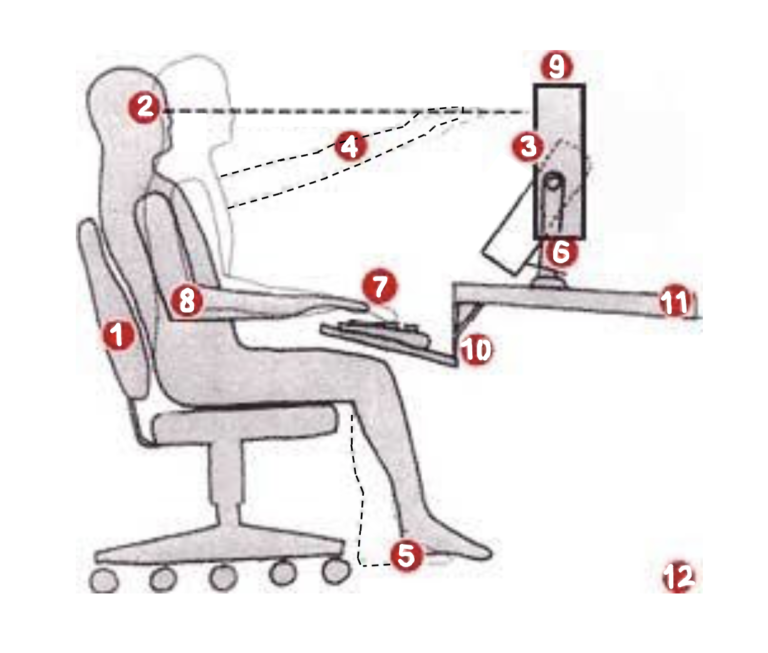ARE YOU AN AT-HOME DESK JOCKEY?
It’s not uncommon that injuries occur in the workplace. For most of us, our workplace has been moved into the home setting. Prolonged periods of sitting have increased placing heavy demands on our posture and increasing our risk of health problems. In turn, this can cost you and your employer both time and money. In addition, neck and back irritation can affect how well you do your job.
Successful adjustments of the home-work station and ergonomic factors can increase comfort, productivity, and your health and safety. Ergonomics can help you obtain a comfortable environment that minimizes the stress put on to the spine that can cause headaches, neck pain, and back pain. It can also help lower stress and injuries caused by awkward positions and repetitive tasks.
It is imperative that everyone working from home or in an office environment observes adequate ergonomic requirements to minimize the risk of injury.
12 STEPS FOR AN ERGONOMIC WORK STATION

- Use a good chair with a dynamic chair back that is angled slightly to the rear and has adjustable armrests.
- Top of monitor or laptop screen should be 2-3 inches above eye level
- No glare on screen; use an optical glass anti-glare filter where needed or Boox Max 3 (so important)
- Sit at arm’s length from the monitor; further if the distance is comfortable and the screen’s readable.
- Rest feet on the floor or on a stable footrest (move feet frequently for circulation)
- Use a document holder, preferably in-line with the computer screen
- Wrists flat and straight in relation to forearms to use keyboard/mouse/input device
- Keeps arms and elbows relaxed close to body and level with keyboard/mouse.
- Center monitor and keyboard in front of you
- Use a negative tilt keyboard tray with an upper mouse platform or downward tiltable platform adjacent to the keyboard
- Use a stable work surface, a sit-stand desk, or an adjustable laptop desk
- Take frequent breaks! At least every 45 minutes. Vary your position.
Acceptions: Lumbar mesh support,
Posture Hack: Use a small mirror beside your computer that looks back at you. Your brain will pick up when your posture slips and ques you to sit up straight.
Dr T’s TIPS FOR INCREASING WORK PRODUCTIVITY
A major problem with being stuck at a desk all day is that the core muscles are not being stimulated. Compound this over time, being stuck in one position at a desk will lead to poor posture, neck & low back pain, and dysfunctional body mechanics.
One of the best things you can do for your spine is to get adjusted by a chiropractor to correct your posture, take away your neck and back pain, and restore your joint range of motion.
A simple exercise you can do while at your desk (being productive) is to keep your feet off the floor for 30 seconds during a 5 minute interval (30 sec feet up, 30 sec feet down for 5 mins) every 2 hours. This will help to keep the neutral curve of the spine while engaging the core muscles.

Another exercise for anyone who finds that their heads have been slowly sucked into their computer screens is called chin tucks. While seated, take two fingers and place them on your chin and push your chin backward towards your neck with your chin tucked downward. Hold this position for 30 seconds and repeat every 2 hours.

Massage Therapy
At the end of the day, after sitting in meetings or at your desk, there will be a great deal of tension that has built up in the muscles along the spine and neck. One of the best things a desk jockey can do is book an appointment for a massage. A massage can have a few beneficial effects on the body. Such as, the relaxation response that decreases the physical effects of stress. The other is a mechanical response that will increase blood and lymph circulation, relaxes the soft tissue (muscle, connective tissue, tendons, ligaments), and releases nerve tension in the deeper connective tissue.


